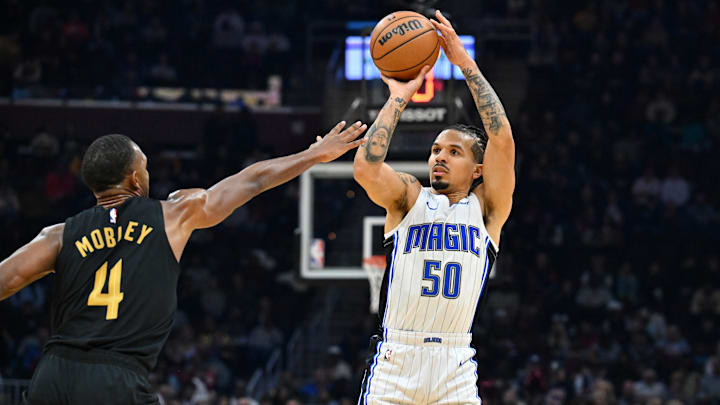Fresh off a three-day layoff, the Cleveland Cavaliers hosted the rising Orlando Magic on Wednesday night and were uppercutted early with a flurry of interior action that persisted the entire evening. On top of that, the Wine and Gold were untidy, committing more fouls than usual. But the group made up for it in other areas defensively for one of its top wins of the season, 121-111.
The Magic were held below their averages in long-range efficiency facing man-to-man and zone coverages. Twenty-eight minutes passed before the Mickey Mouse team logged a triple. Franz Wagner was shut down. And Cleveland had a set defense for 83.3% of the time Orlando was on offense.
Here’s how it happened defensively:
Defending Paolo Banchero:
Jarrett Allen matched up with Banchero first before the switch, forcing a miss at close range but also getting blown by at the wing for a layup. When the up-and-coming magic phenom went back at J.A. from the opposite wing, the pressure on the dribble forced a turnover.
He took his first rest with 10 points on four of six shots.
In the second quarter, he dusted Allen again from the top to the cup for an inside finish, but throughout, he was his team’s offense. Banchero created breakdowns while maneuvering inside and drawing contact for trips to the line. After 24 minutes, he registered 20 points on 77% shooting with four trips to the line.
In this span, the rest of the Magic logged 11 of 29 ventures.
After halftime, he exploited mismatches for easy access to the basket, glided on the break and broke down Tristan Thompson, Dean Wade, Georges Niang and Allen off the dribble in the lane and outside.
Defending the Arc:
The Cavaliers permitted zero of 10 3-point makes to fall in the first half. Being on time against the drive and kick and setting high pick-up points on the shooters disrupted Orlando’s long-range attack.
In the second half, Orlando didn’t do much better, finishing the night with two made 3-pointers. Cleveland’s outside pressure didn’t relent, contesting cleanly.
Pain Protection:
Early bleeding lasted until the end as the Magic dropped 68 points in the paint. For context, in 15 games in November, Cleveland opponents averaged 45.3 paint points.
In the first half, the restricted area was the only area the Magic scored efficiently with 14 of 19. In the rest of the lane during this time, Cleveland allowed 20% of tries to fall.
Ball-watching caused the Cavaliers to lose cutters and the rock wasn’t stopped outside, which allowed handlers to get downhill with speed and force.
In quarters three and four, Cleveland struggled with Banchero’s speed and power, conceding 14 points just to him in the box. Their next successful rim assaulter was Moritz Wagner on rim rolls and cuts. In this span, Orlando converted 24 of 29 buckets in the lane.
If not for Mobley denying F. Wagner and Thompson’s helpside block on Banchero’s drive, the Magic would have hung over 70 interior points.
Transition:
Sloppiness with the ball gave Orlando extra possessions, but it took out-of-control shots when it turned on the jets because the Cavaliers had a man trailing. Through four quarters, Cleveland held Orlando to 58.3 points per 100 transition plays.
Defensive rebounding:
The Cavs took care of business on the glass in the first half, allowing one offensive rebound to Orlando and four second-chance points. Recovering misses quickly sparked the offense via outlet pass or a coast-to-coast drive.
In the second half, Orlando snatched six offensive boards because of lucky bounces and getting nastier under the basket, which turned into seven second-chance points.
For the match, the Cavaliers recovered 74.4% of available defensive rebounds.
Defending without fouling:
This was another weakness in the first half. Guys were too loose with their hands against drives and jump shots, plus they bit on fakes, which put Orlando on the line for 16 of 23 freebies. This had a negative effect on Cleveland’s offense because it gashed into the flow it had established, forcing them to play against a set defense again and again.
In the last two quarters, Cleveland committed the same mistakes, and Orlando finished the night with 27 of 37 makes at the line.
Final Grade:
The outside protection was stellar, but the trade-off was too steep, even for a win. The Cavaliers can hold an opponent below its averages from inside and out, so the only mark appropriate here is a C.
